What Is the Penetration Test?
Important Point
The resistance is empirically correlated with some of the engineering properties of soil such as density index, consistency, bearing capacity, etc.
The values of these tests lie in the amount of experience behind them. These tests are useful for general exploration of erratic soil profiles, for finding the depth to bedrock or hard stratum and to have an approximate indication of the strength and other properties of soils, particularly the cohesionless soils, from which it is difficult to obtain undisturbed samples.
Here, two different types of tests of Penetration ara as follows.
-
- The Standard Penetration Test.
- The Cone Penetration Test.
Also, read: What Is a Bar Bending Schedule | Preparation as Per Bs 4466 | Tolerances as Per Bs 4466
What is the SPT Test?
- SPT full name is Standard Penetration Test. The meaning of SPT test is to determine the penetration resistance of the soil.
- The standard penetration test is coming under the category of penetrometer tests.
- An empirical penetration correlation is derived between the soil properties and the penetration resistance.
- This test (IS: 2131-1981) is performed in a clean hole 55 to 150mm (millimeter) in dia
- A casing or drilling mud can be used to support the sides of the hole. A thick-wall split-tube sampler, 50.8 mm OD and 35 mm ID, is driven into the undisturbed soil into the bottom of the hole under the blows of a 63.5 kg drive weight with 75 cm free fall.
- The minimum open length of the sample should be 60 cm.
Also, read: Total Station in Surveying | Operations | Advantage & Disadvantage | Types
Procedure for Standard Penetration Test:
- Test procedure: The SPT test procedure involves the split tube sampler, commonly known as split spoon sampler resting on the bottom of the borehole is allowed to sink under its own weight.
- It is then seated 15 cm with the blows of the hammer falling through a height of 75 cm. Then, the split spoon sampler is further driven by 30 cm or 50 blows.
- The number of blows required to affect each 15 cm penetration is recorded.
- The first 15 cm of the drive is considered to be seat drive.
- The total blows necessary for the second and third 15 cm of penetration is termed as the penetration resistance N.
- In case the split spoon sampler is driven less than 45 cm (total), then the penetration resistance will be for the last 30 cm of penetration.
- The whole sampler may sometimes sink under its own weight when very soft subsoil stratum is encountered.
- Under these conditions, it might not be necessary to give any blow for a sampler, and SPT value should be indicated as zero.
- Corrections to Be Observed N Values.
- Overburden Pressure Correction by Other Workers.
- Correlation of N with Soil Properties.
#1. Corrections to Be Observed N Values-
The observed value of N is correct for SPT correction for Overburden
- Correction for Overburden.
- Correction for Dilatancy/submergence.
#1a. Correction for Overburden-
A density classification for sands has been proposed originally, in general terms, by Terzaghi and Peck, on the ground of standard penetration resistance, as shown in columns (1) and (2) of as per below table.
| (1)
N value |
(2)
Classification |
(3)
lo (%) |
(4)
(N1)60 |
| 0-4 | Very loose | 0-15 | 0-3 |
| 4-10 | Loose | 15-35 | 3-8 |
| 10-30 | Medium dense | 35-65 | 8-25 |
| 30-50 | Dense | 65-85 | 25-42 |
| >50 | Very dense | 85-100 | 42-58 |
Numerical values of density index, as shown in column (3), were then added by Gibbs and Holtz. But, standard penetration resistance is dependent not only on density index but also on the effective stresses at a depth of measurement; effective stresses can be represented into a first approximation by effective overburden pressure.
This dependence has been first demonstrated in the laboratory by resistance at different depths. Several proposals are made for the correction of measured N values after the work of Gibbs and Holtz. The corrected value (N1) is related to the measured value (N) by the factor CN, in which and was later confirmed in the field. Sand in the same density index would thus give different values of standard penetration resistance at different depths.
Several proposals are made for the correction of measured N values after the work of Gibbs and Holtz. The corrected value (N 0) is related to the measured value (N) by the factor Cn, where
N 0 = Cn.N————————————— (1)
Cn = Normalising correction factor
Normalizing correction
#1b. Correction for Dilatancy/submergence-
The values N o obtained after applying overburden correction is corrected further for dilatancy if the stratum consists of fine silt and sand below the water table, for values of N greater than 15, using the following expression:
N e = 15 + (N 0 – 15 )
Also, read: What is Plum Concrete | Application | Mix Design | Methodology
#2. Overburden Pressure Correction by Other Workers-
For a constant density index, the N value increase with increasing effective overburden pressure for which correction has been proposed by Gibbs and Holtz, Peck, Thornburn, Whitman, and others.
Gibbs and Holtz (1957) have experimentally studied the effect of overburden pressure on the values of N. Their modification for air dry or moist sand can be represented by the relation :
N 0 = N ( 500 / 1.42σ + 100 ) ————————————— (2)
- N 0 = Corrected Value for Overburden Effect
- N = Actual Value
- σ = Effective Overburden Pressure (Not Exceed 282 kN/sq.mm)
Peck (1974) proposed that N values be reported at a reference overburden pressure of 100 kN/Sq.m., and the normalized value of N (Corrected for Overburden Pressure) be expressed as follows:
N 0 = Cn.N
- Cn = Normalizing Factor
- = 0.77 log10 (2000/σ)————————————— (3)
- σ = Effective overburden pressure (kN/Sq.m) at the test level.
The above correction is valid for σ > 25 kN/sq.m. It may be noted that at reference overburden pressure of 100 kN/sq.m., Cn = 1. If σ decreases below reference pressure, Cn increases; at σ = 50 kN/sq.m Cn = 1.234. However, if σ increases above the reference overburden pressure of 100 kN/sq.n., Cn becomes less than unity; at σ = 400 kN/sq.m., Cn = 0.54. Eq. 3 is represented by curves of as per above figure adopted by BIS.
Lio and Whitman (1986) has proposed the following expression for Cn
Cn = √(2000/σ ) ————————————— (4)
- Here again at σ = 100 kN/Sq.m, Cn = 1
- σ = 50 kN/Sq.m, Cn = 1.141
- σ = 400 kN/Sq.m, Cn = 0.5
Correlation of N with Soil Properties:
| Corrected N | 5 | 10 | 15 | 20 | 25 | 30 | 35 | 40 | 45 | 50 |
| Ø | 29. | 30 | 32 | 33 | 35 | 36 | 38. | 39 | 40 | 43 |
Relation between N and Ø table 2
As per the above table 2 gives the relation between corrected N value and angle of shearing Ø resistance, as suggested by Peck (1974).
Relation between N and Ø
As per the above figure gives the graphical relationship between corrected N value and angle Ø as adopted by Indian Standard (IS: 6403-1981). This value of Ø can then be used for finding capacity factors Nc, Nq, and Ny
As per below table 3 and 4 give some empirical correlations of the soil properties with corrected penetration resistance. The approximate values of 4 are after Meyerhof (1956)
| Penetration Resistance N (Blows) | Approx. Ø (Degrees) | Density Index (%) | Description | Approx. Moist Unit Weight (Kn/m.cubic) |
| — | 25-30 | 0 | ||
| 4 | 27-32 | 15 | Very loose | 1.12-1.6 |
| 10 | 30-35 | 35 | Loose | 1.44-1.84 |
| 30 | 35-40 | 65 | Medium | 1.76-2.08 |
| 50 | 38-43 | 85 | Dense | 1.76-2.24 |
| — | 100 | Very dense | 2.08-2.40 |
Table 3 Penetration resistance and empirical corrections of cohesionless Soils
Also,
- Ø = 25 + 0.15 Id , with fine greater than 5%
- Ø = 30 + 0.15 Id, with fine less than 5%
Larger values could be used for granular soil with 5% or less fine silt and sand
| Penetration Resistance (Blows) | Unconfined Compressive Strength (T/sq.m) | Saturated Density (T/m.cubic) | Consistency |
| 0 | 0 | – | Very soft |
| 2 | 3 | 1.6-1.92 | Soft |
| 4 | 5 | – | Medium |
| 8 | 10 | 1.76-2.08 | Stiff |
| 16 | 20 | 1.92-2.24 | Very stiff |
| 32 | 40 | – | Hard |
Table 4 Penetration resistance and empirical corrections of cohesive Soils
Efficiency of Standard Penetration Testing:
The actual energy effective in the driving of the SPT equipment varies due to many factors.
Hence, in addition to the effective overburden stress at the tested location, the SPT parameter depends on the following additional factors:
- Hammer Efficiency.
- Length of Drill Rod.
- Sampler.
- Borehole Diameter.
Also, read: What Is Raft Foundation | Type of Footing | Detail of Raft Footing
Advantages and Disadvantages of Standard Penetration Test
Advantages of Standard Penetration Test
- This very simple and economical.
- This test provides a representative sample 0for visual review.
- Actual soil behavior is accessed through the Standard Penetration Test values.
- The method will help to penetrate dense fills and layers.
- The test may be applied for a variety of soil conditions.
Disadvantages of Standard Penetration Test
- The results will vary because of any operator or mechanical variability or drilling disturbances.
- Teat very costly also time-consuming.
- The test results from the Standard Penetration Test can’t be reproduced.
What Is Meant by Standard Penetration Test?
What is meant by Standard Penetration Test? It’s a simple and low-cost testing procedure widely used in geotechnical investigation. The cost of standard penetration test is justified by its ability to determine the relative density and angle of shearing resistance of cohesionless soils and also the strength of stiff cohesive soils.
How Is Standard Penetration Test Calculated?
The sum of the number of blows required for the second and third 6 inches of penetration is termed the “standard penetration resistance” or the “N-value”. In cases where 50 blows are insufficient to advance it through a 150 mm (6 in) interval the penetration after 50 blows is recorded.
What Is SPT Drilling?
What is SPT drilling? The Standard Penetration Test (SPT) is a widely employed soil exploration tool that involves using a SPT hammer to drive a split barrel sampler at the bottom of a drill string to obtain soil samples.. The number of blows required to penetrate the last 300mm (1ft) is the “N value”, which is related to soil strength.
Standard Penetration Test
The standard penetration test pdf provides detailed insights into the standard penetration test, commonly known as ‘SPT’. This test was developed to provide geotechnical engineering properties for foundation design purposes. The test is carried out within a borehole. The results can be used to determine the relative density, bearing capacity, and settlement of granular soil.
What Is SPT N Value in Soil Test?
What is SPT N value in soil test? The SPT (N) value provides information regarding the soil strength. SPT (N) value in sandy soils indicates the friction angle in sandy soils and in clay soils indicates the stiffness of the clay stratum.
What Is SPT Boring?
The number of blows required to drive the sampler through the 6- to 18-inch interval is termed the SPT N-value and is indicated for each test interval on the test boring logs. The SPT N-values are reported as the number of blows per foot (bpf) of sampler penetration.
Standard Penetration Test N Value
The standard penetration test (SPT) is an in-situ dynamic penetration test designed to provide information on the geotechnical engineering properties of soil.
Correlation with soil mechanical properties.
| Relative Density | SPT N Value | Bulk density (kg/m³) |
| Medium | 11-30 | 1750-2100 |
| Dense | 31-50 | 1750-2245 |
| Very Dense | >50 | >2100 |
| Very Loose | 0-4 | <1600 |
| Loose | 5-10 | 1530-200 |
Standard Penetration Test Procedure
A hammer of 63.5 kg (140 lbs) is dropped repeatedly from a height of 76 cm (30 inches) driving the sampler into the ground until reaching a depth of 15 cm (6 inches). The number of the required blows is recorded. This procedure is repeated two more times until a total penetration of 45 cm (18 inches) is achieved.
What Is N Value of Standard Penetration Test?
The measured N-value (blows/0.3 m) is the so-called standard penetration resistance of the soil. The penetration resistance is influenced by the stress conditions at the depth of the test.
Standard Penetration Test of Soil
The SPT test of soil, also known as the Standard Penetration Test (SPT), is a simple and low-cost testing procedure widely used in geotechnical investigation.
How Do You Interpret SPT and Value?
The number of blows for that 300 mm becomes the N-value. It can be done in the bottom of a borehole or at the surface. In the United States, the standard test procedure is ASTM D1586. Typical values are 0-10 for sand, 5-10 in loose clay and 10-30 in compacted clay.
What Is N Value in Soil Testing?
The N-value provides an indication of the relative density of the subsurface soil, and it is used in empirical geotechnical correlation to estimate the approximate shear strength properties of the soils.
Standard Penetration Test Equipment
Tools requirements to conduct SPT are Standard Split Spoon Sampler, Drop Hammer weighing 63.5kg, Guiding rod, and a Drilling Rig Driving head (anvil). The split-spoon sampler used in the SPT is driven into the soil at the bottom of the borehole with a 140-lb hammer falling 30 inches.
What Is SPT Machine?
The standard penetration test aims to determine the resistance of soils at the base of a borehole to the dynamic penetration of a split barrel sampler and the recovering of disturbed samples for identification purposes. In gravelly soils and soft rock, a solid cone is used SPT(C).
How SPT Is Done?
How is the SPT soil test done? The test uses a thick-walled sample tube, with an outside diameter of 50.8 mm and an inside diameter of 35 mm, and a length of around 650 mm. This is driven into the ground at the bottom of a borehole by blows from a slide hammer with a mass of 63.5 kg (140 lb) falling through a distance of 760 mm (30 in).
Why SPT Test Is Done?
Why standard penetration test is used to determine? The standard penetration test, commonly known as ‘SPT’, was developed to provide geotechnical engineering properties for foundation design purposes. The test is carried out within a borehole. The results can be used to determine the relative density, bearing capacity, and settlement of granular soil.
Like this post? Share it with your friends!
Suggested Read-
- Fall on Canal
- Consistency Test
- West Point Bridge Designer
- Building Estimate Format in Pdf
- What Is Plaster | Type of Plaster | Defects In Plastering
- What Is Unit Weight | What Is Density | What Is Unit Weight Material | Unit Weight Building Materials
- What Is Diversion of Headworks (Rivers) | Types of Diversion Headworks | Component Parts of Diversion Headworks (Rivers)
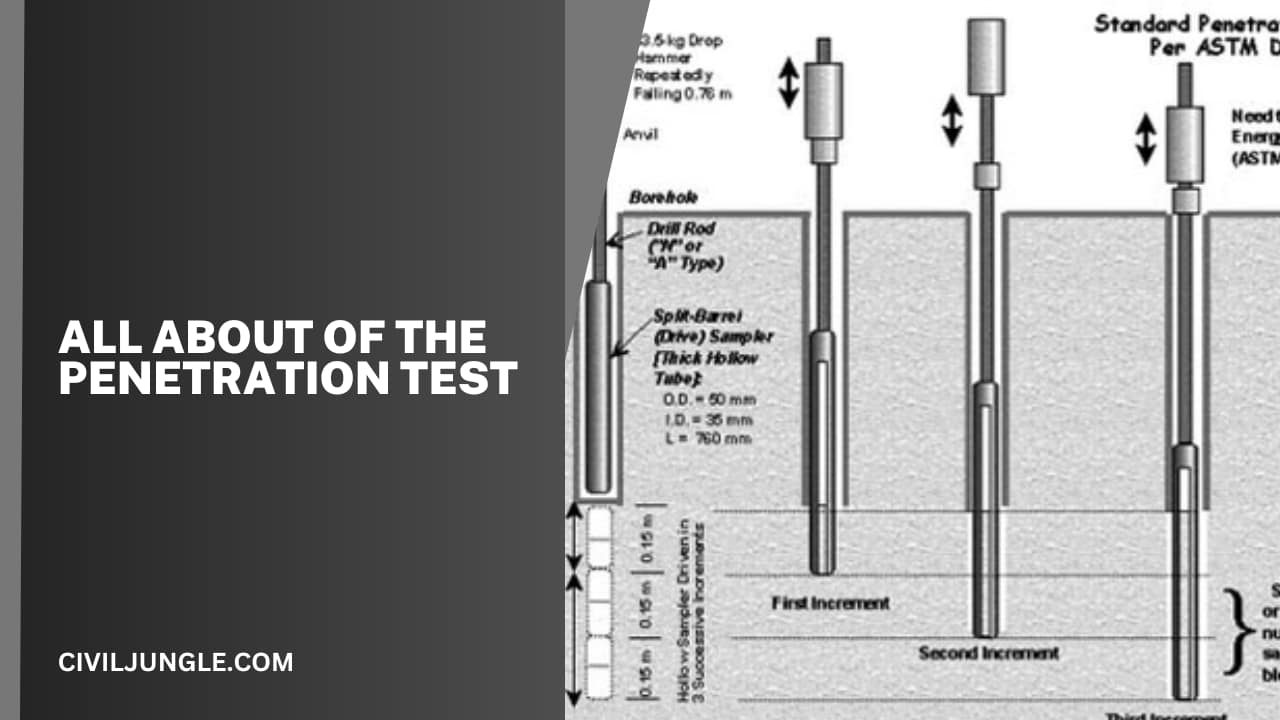

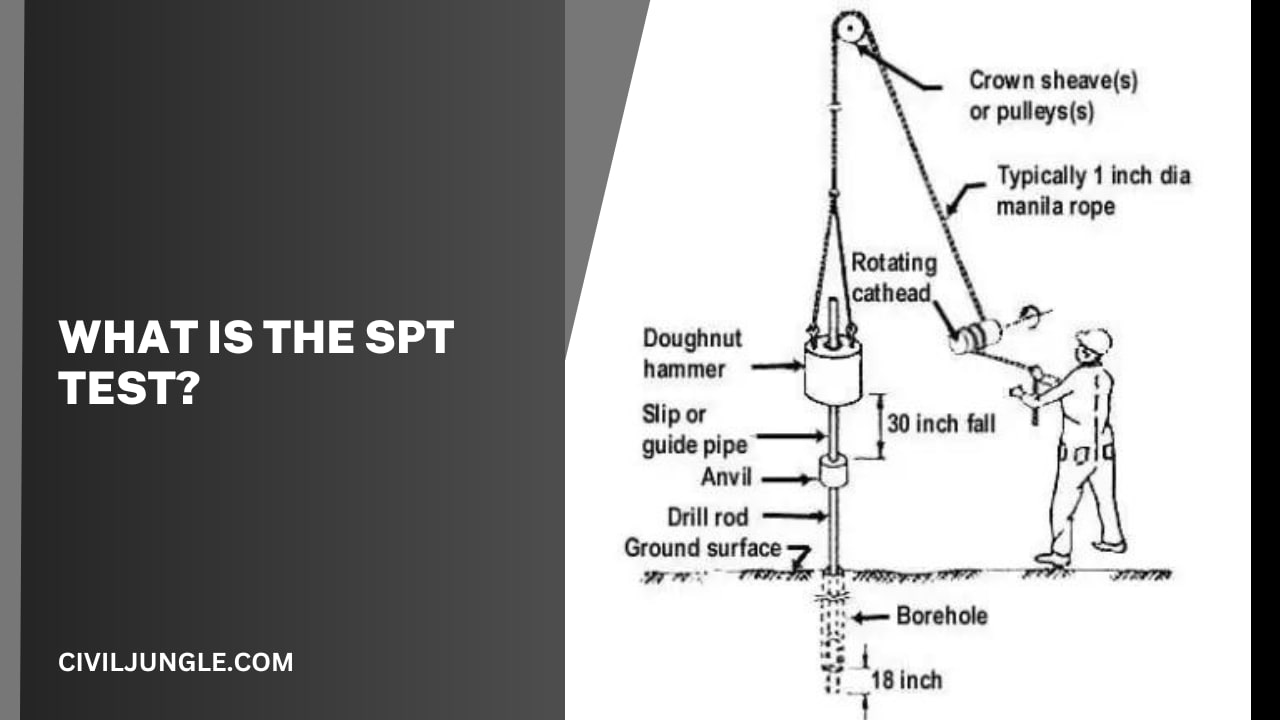
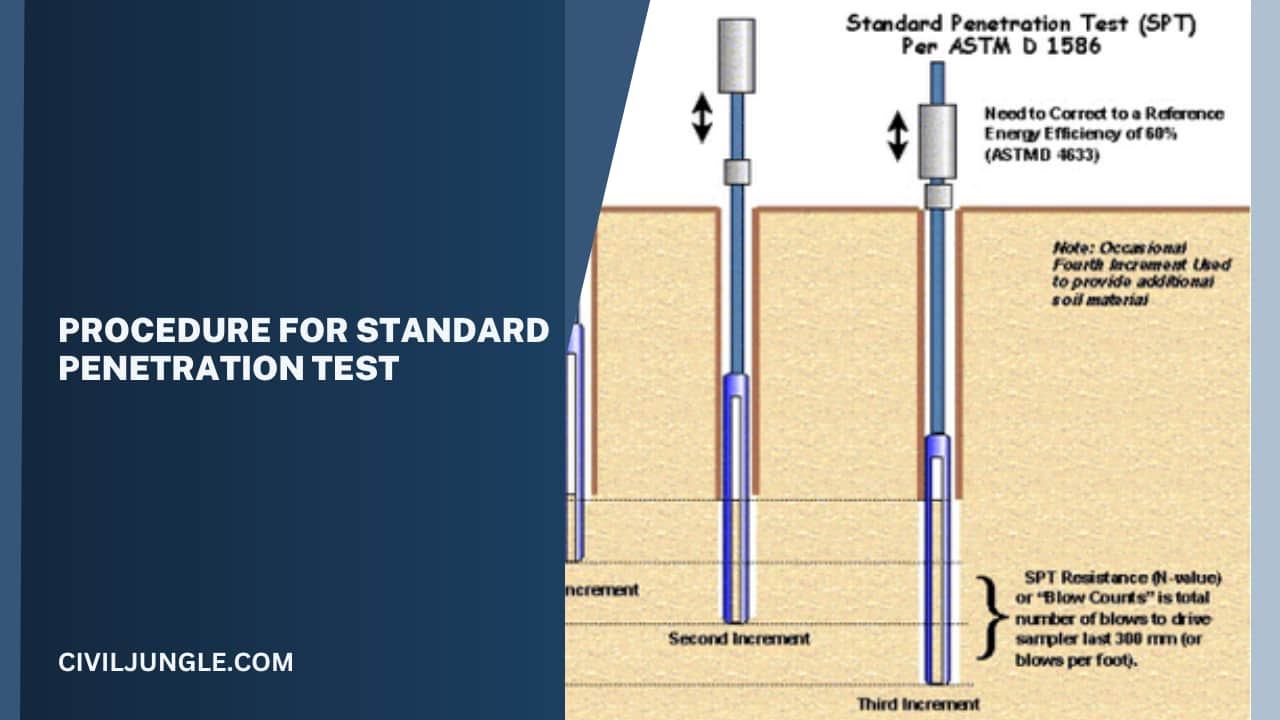

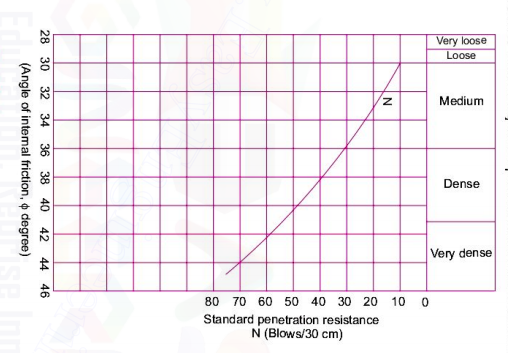
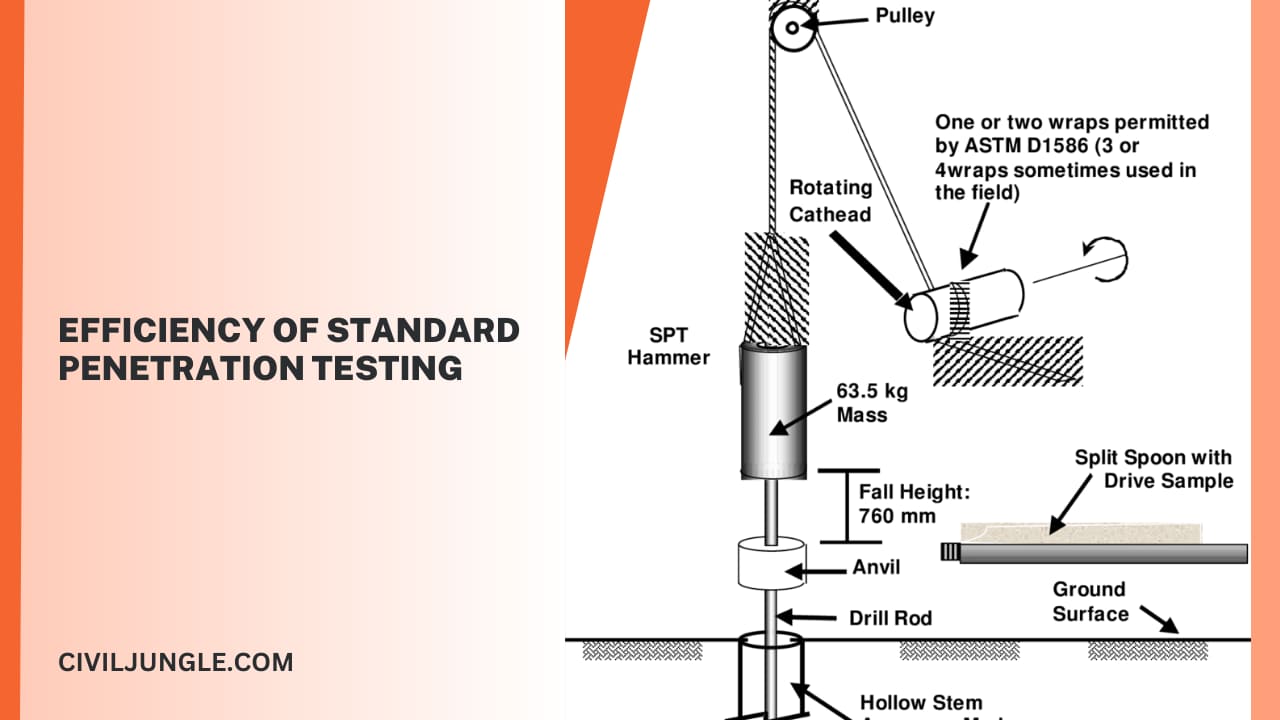

Leave a Reply